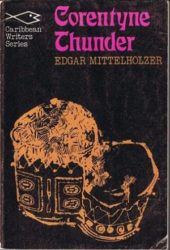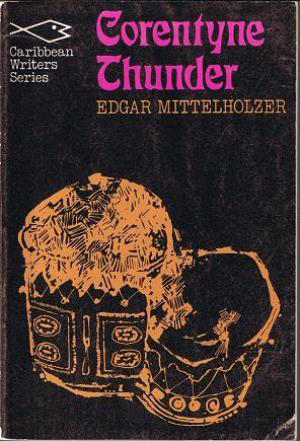2016 is already a very important year for anniversaries. For the nation of the Republic of Guyana it is most significant because it is the country’s 50th year since Independence and Golden Jubilee celebrations dominate its cultural agenda. Barbados is also commemorating 50 years as an independent nation, and it feels as if the Caribbean has only just recovered from the Independence anniversaries of Jamaica and Trinidad and Tobago.

Narrowing it down to literature, 2016 marked 400 years since the death of William Shakespeare and the month of April belonged to that. Last weekend saw a large and lively programme in England, where there was a strong festival atmosphere particularly in the small city of Stratford and secondarily in the large city of London. Stratford-Upon – Avon is the famous town where he was born – now teeming with theatres, shrines, museums and crowds of tourists by the River Avon with its large symbolic swans gliding imperially on the water and basking on its banks. These theatres include The Swan, created and named in honour of the Swan Theatre in London where Shakespeare worked and made his fame.

The company was joined by great multitudes in very colourful festivals in Stratford and London along with extensive coverage and programmes of its own by the BBC. Neither did it go unnoticed in the Caribbean where there were special presentations during the annual NGS Bocas Literary Festival in Port of Spain up to yesterday.
Miguel de Cervantes, the greatest Spanish writer and author of the immortal classic El Ingenioso Hidalgo Don Quixote de La Mancha was also celebrated. April 23 was also the 400th anniversary of his death. There were somewhat less fireworks around that, but it was acknowledged as another significant event in literary anniversaries.
Marking the anniversary of books is also customary. There was much fanfare, for example, over the 50th anniversary of the celebrated Catcher in the Rye by the reclusive American JD Salinger. Equal noise accompanied the more recent Golden Jubilee of the highly acclaimed To Kill A Mockingbird by the equally reclusive American novelist Harper Lee. The Caribbean, and of course, Barbados in particular, celebrated the 50th year of the iconic novel In the Castle of My Skin by legendary author George Lamming.
It might have escaped universal acknowledgement, but 2016 also marks a very worthwhile anniversary – it is the 75th year since the publication of Corentyne Thunder (1941) by Guyana’s foremost and exemplary professional fiction writer Edgar Mittelholzer. This book is important since it virtually launched his career as the first of his novels internationally published. Moreover, that publication set off social realism in Guyanese fiction just as HG De Lisser (1913) and CLR James (1929) did for Jamaica and Trinidad respectively.
Mittelholzer, however, will get his share of anniversary acclaim very soon, since during this month he will be a feature of the national Golden Jubilee celebrations. A series of literary events highlighting milestones in Guyanese literature will be launched on May 3. The various presentations, round-table discussions, performances, lectures and exhibitions will take literature around the country as part of the national Jubilee timetable. Events to be held in New Amsterdam will focus the town as Mittelholzer’s birthplace and Berbice, if not the Berbice River, as the setting for some of his books.
Going wider afield in international literature, 2016 is the 50th anniversary of the publication of one of the most celebrated novels of the Caribbean. Although not a part of the literature of the 1950s that virtually launched West Indian literature around ‘exile’ and Caribbean Voices on the BBC, it remains one of the foundations of West Indian literature. That book is the novel Wide Sargasso Sea by Dominican writer of fiction Jean Rhys.
Wide Sargasso Sea was first published in 1966 by Andre Deutsch and it was a remarkable gain for West Indian literature. It was a success and introduced some added life and influence to the literature that was coming into its own. After its major rise in the 1950s the body of writing was still on the fringe, on the edge of acceptance as a full member of the mainstream. Rhys’ novel introduced a significant measure of originality and inventiveness in the form of the West Indian novel. Besides, it dealt with historical, cultural, racial and colonial issues important to the Caribbean at a time when islands of the West Indies were beginning to gain independence, and the continental based Guyana gained hers.
The novel attracted attention because of these factors and its fresh and influential treatment of the pertinent themes. Crucial to all of this was its pioneering role as a novel with strains of feminism coming out of the region. As a post-colonial work it also drew attention to itself, and its fine quality, its excellence of craft and extraordinary narrative style made it a landmark in the literature. It took its place as one of the foundation novels of the emerging West Indian Literature.
Another reason for the great interest in Wide Sargasso Sea is that it rescued and regenerated interest in the career of Jean Rhys. What is more, it was her reappearance to the world after several years of disappearance. She had previously published novels and several short stories in a writing career that launched itself in 1927 as far as published work is concerned. After another publication in 1929, there was quite an outpouring of work through the decade of the thirties, but after 1939, a long silence. In the forties she “all but disappeared from public view”. She was only “recalled to life” with that new novel in 1966.
Rhys was born Ella Gwendolyn Rees Williams in 1910 in the West Indian island of Dominica. Her father was a Welsh doctor and her mother a white creole Dominican. She went to England at 16 and her discomfort with the place, particularly its climate, bleak grey weather, lack of colour, and the unfriendliness of her European classmates at boarding school were recorded in much of her later writing. Even though she lived in Cornwall, England from 1955 for the rest of her life, she never seemed very happy there.
To make things worse, she had an intense interest in a career in the theatre and went to acting school. But she was more deeply ‘othered’ as a West Indian, never mind a white one, and was literally alienated as an outsider – an experience that was to impress itself upon her writing much later on. Without completing drama studies she worked for a while as an actress in touring companies, leaving for Europe and living in France. That was an unsettled and unsettling period of her wandering life before she seriously settled as a writer under the help and influence of Ford Maddox Ford, who advised her to publish under the new name: ‘Jean Rhys’.
Examples of her work arising from this are The Left Bank and Other Stories, Quartet and Voyage in the Dark. One of the major strengths of Wide Sargasso Sea is the application of its title to the novel, which is of interest to its place as a defining Caribbean work of post-colonialism. It is said that there is a large expanse of sea in the Atlantic Ocean somewhere between Bermuda and Europe which is covered in miles of the Sargasso weeds. This vegetation in the water chokes and entangles and is dangerous for any who venture into it. As a result it acts as an alienating force, separating the Caribbean from Europe.
The writer uses this symbolically in a novel which delves into alienation and the forces which bring the English to the West Indies but drive them asunder. This remains always as an undercurrent in a novel about colonial conditions in the West Indies in the immediate post-slavery period. There was conflict between the local whites and the former black slaves, as much as there was conflict between the local creole whites and those from England.
It is a novel of dispossession – economically, but also very much about the oppression of women, dispossessed by the colonial patriarchal society as by a race of colonisers. It is sensitively narrated by the voice of the dispossessed and the alienated as well as by the villain of the piece who feels a victim of his home society in England as well as of a society in the West Indies of which he is suspicious and that he does not understand.
Wide Sargasso Sea was originally written as a prequel to Emily Bronte’s English novel Jane Eyre, since Rhys wanted to give voice, personality and sympathetic background to the mad woman in the attic in that. But ‘Bertha’s’ story took life of its own and lives very independently as a story which traces the victimhood of the West Indian under slavery and colonialism. More than that it also traces female victimhood under patriarchy, and tells a story of a woman who exacts some satisfactory measure of revenge against an oppressor who brings her to exile in an English attic.
This is the basis of an exceedingly successful novel that holds a commanding place in the literature of the Caribbean and celebrates its golden jubilee in 2016.





